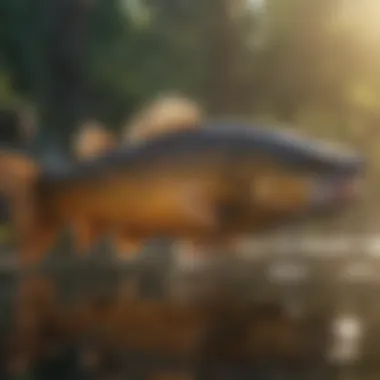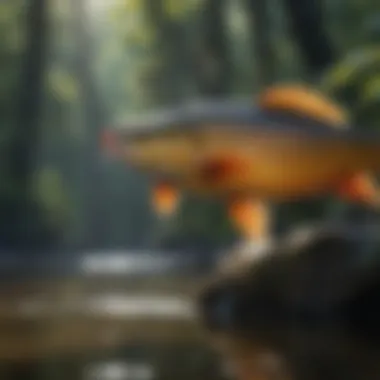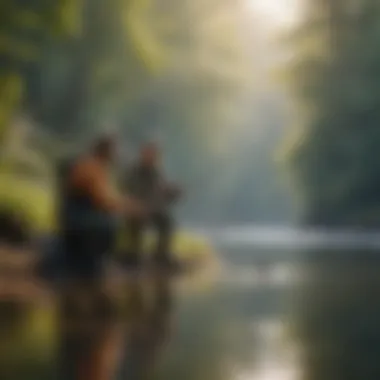In-depth Analysis of Major and Minor Aspects in Fishing Industry


Overview of the Topic
Fishing, a vital industry worldwide, has both major and minor aspects that significantly impact the natural environment and human societies. It involves various techniques, regulations, and challenges that shape the intricate world of fisheries. Understanding the dynamics between major fishing practices and minor regulatory measures is crucial for sustainable resource management.
Current Status and Challenges
Currently, the fishing industry faces numerous challenges, including overfishing, bycatch of non-target species, habitat destruction, and seafood fraud. These issues threaten marine ecosystems, biodiversity, and the livelihoods of fishing communities. Proper management and strict enforcement of regulations are essential to address these challenges and ensure the long-term viability of fish stocks.
Sustainable Solutions
To tackle the sustainability crisis in fishing, a shift towards responsible practices is imperative. This involves implementation of measures such as quotas, marine protected areas, gear modifications to reduce bycatch, and traceability systems to combat illegal fishing. Successful case studies showcase the positive impact of sustainable fishing practices on both marine resources and coastal communities.
Impact and Importance
The impact of fishing extends beyond the ocean waters; it influences ecosystems, economies, and food security globally. Unsustainable fishing practices can lead to the collapse of fish populations, affecting entire food chains and threatening the balance of marine ecosystems. Therefore, prioritizing conservation efforts, sustainable resource management, and community engagement is paramount to safeguarding fish stocks and marine biodiversity for future generations.
Introduction to Fishing
Fishing, an age-old practice deeply rooted in human history, serves as a significant industry worldwide. This section of the article aims to unravel the fundamental elements of fishing, shedding light on its multifaceted nature. By delving into the evolution of fishing practices and the significance of the fishing industry, readers will gain a comprehensive understanding of the crucial role fishing plays in both economic and environmental realms.
Evolution of Fishing Practices
The advent of modern fishing techniques
The evolution of fishing practices has seen a profound shift with the introduction of modern techniques. Innovations such as sonar technology, GPS navigation, and advanced gear have revolutionized the way we approach fishing. These modern tools enhance efficiency, enabling fishermen to target specific species with precision. Despite their advantages, modern techniques also raise concerns about overfishing and ecosystem disruptions. Understanding the impact of these methods is crucial for sustainable fishing practices.


Impact of traditional methods
Traditional fishing methods, passed down through generations, have a deep-rooted impact on the fishing industry. Practices like handline fishing and net fishing have sustained communities for centuries, providing livelihoods and cultural identity. While they may lack the precision of modern techniques, traditional methods often minimize bycatch and environmental harm. Balancing the benefits of tradition with the need for technological advancement is a key consideration in the evolution of fishing practices.
Significance of Fishing Industry
Economic contributions
The fishing industry makes substantial economic contributions globally, supporting livelihoods and driving regional economies. From small-scale artisanal fisheries to industrial fleets, fishing activities generate income, employment, and trade opportunities. However, economic gains must be balanced with sustainable practices to prevent overexploitation of marine resources and ensure long-term prosperity for coastal communities.
Global food security
Fisheries play a vital role in ensuring global food security, providing a key source of protein for millions of people worldwide. As populations grow and demand for seafood rises, maintaining sustainable fishing practices is critical to safeguarding food supplies. By understanding the interconnectedness of the fishing industry with food security, policymakers and stakeholders can work towards a more resilient and equitable food system.
Major Fishing Techniques
Fishing is a multifaceted industry, with major fishing techniques playing a pivotal role in the sustainability and efficiency of operations. These techniques encompass a range of methods such as trawling and longlining, each with its unique benefits and considerations. Understanding major fishing techniques is crucial for optimizing harvests while minimizing adverse impacts on marine environments. By delving into the intricacies of trawling and longlining, we gain valuable insights into the dynamics of harvesting aquatic resources.
Trawling
Impacts on marine ecosystems
Trawling, a commonly employed fishing method, significantly impacts marine ecosystems due to its widespread use and potential for habitat disturbance. The aggressive nature of trawling operations can result in the destruction of sensitive marine habitats and adverse effects on non-target species. Despite these drawbacks, trawling remains a popular choice for commercial fishing endeavors due to its high efficiency in capturing large quantities of fish. The unique feature of trawling lies in its capacity to cover extensive areas of the seafloor, making it a preferred technique for maximizing catch volumes.
Regulations and sustainability measures
To mitigate the ecological consequences of trawling, stringent regulations and sustainability measures have been implemented to control fishing practices and protect marine biodiversity. These regulations aim to minimize bycatch, reduce habitat destruction, and promote sustainable fishing practices. While facing some criticism for its environmental impacts, trawling has been subject to ongoing improvements and sustainable initiatives to enhance its compatibility with conservation goals. The balance between regulatory frameworks and the demand for seafood highlights the ongoing debate surrounding the sustainability of trawling within the fishing industry.


Longlining
Target species
Longlining, a methodology focusing on the use of lines with baited hooks, targets specific species of fish for harvest. This targeted approach allows for selective fishing, minimizing the capture of non-target species and reducing bycatch levels. The key characteristic of longlining lies in its ability to target particular fish populations without causing significant disruptions to marine ecosystems. As a specialized fishing technique, longlining offers a valuable strategy for maintaining sustainable fish stocks while meeting commercial demands for specific species.
Bycatch mitigation
Bycatch mitigation measures within longlining operations are crucial for reducing the unintended capture of non-target marine species. These measures include the use of circle hooks, changing bait types, and implementing spatial and temporal restrictions to minimize interactions with vulnerable species. The unique feature of bycatch mitigation in longlining is its adaptability to different fishing scenarios, allowing for tailored approaches to specific bycatch challenges. While not without challenges, the effectiveness of bycatch mitigation techniques highlights the ongoing efforts to enhance the sustainability of longlining practices in the fishing industry.
Minor Aspects in Fishing
Fishing is not just about the catch, but also involves various minor aspects that significantly impact the industry. These details may seem minor but play a crucial role in the overall ecosystem management and sustainability. In this section, we delve into licensing and quota systems, shedding light on their importance in ensuring responsible fishing practices. Licensing and quota systems are regulatory measures put in place to manage and monitor fishing activities effectively. By limiting the number of fish that can be caught, these systems help prevent overfishing and promote long-term conservation of marine resources. Additionally, they also aim to maintain a balance between environmental protection and economic interests within the fishing industry.
Licensing and Quota Systems
Issues of Overfishing
One of the key challenges in the fishing industry is overfishing, a phenomenon where fish stocks are depleted at an unsustainable rate. Overfishing disrupts the natural balance of marine ecosystems, leading to the decline of fish populations and threatening biodiversity. Licensing and quota systems address this issue by setting specific limits on the amount of fish that can be harvested. By imposing these restrictions, authorities can prevent the depletion of fish stocks and protect marine habitats from irreversible damage. While these regulations may pose challenges for fishermen in the short term, they are essential for ensuring the long-term sustainability of marine resources.
Role in Resource Management
The role of licensing and quota systems in resource management cannot be understated. These systems not only help regulate fishing activities but also contribute to the effective conservation of marine ecosystems. By assigning quotas based on scientific assessments of fish populations, authorities can ensure that fishing remains within sustainable limits. This proactive approach to resource management minimizes the risk of overexploitation and promotes the recovery of depleted fish stocks. Furthermore, licensing and quota systems encourage responsible fishing practices, elevating the standards of environmental stewardship within the fishing industry.
Bycatch Regulations


Bycatch - the incidental capture of non-target species during fishing operations- is a critical issue that affects marine biodiversity and ecosystem health. To minimize the impacts of bycatch, various techniques and regulations have been developed to reduce accidental catch levels. In this section, we explore the different strategies employed to mitigate bycatch and protect non-target species from harm. These techniques include the use of specialized gear, changes in fishing practices, and the implementation of exclusion zones in sensitive habitats. Through stringent bycatch regulations, authorities aim to promote sustainable fishing practices and minimize the unintended consequences of commercial fishing activities.
Impacts on Ecosystem Health
The repercussions of bycatch on ecosystem health are profound, affecting the stability and diversity of marine environments. By inadvertently capturing species such as sea turtles, dolphins, and seabirds, fishing operations disrupt the delicate balance of marine ecosystems. The loss of these non-target species can have cascading effects on food webs and ecological processes, leading to long-term consequences for marine biodiversity. By addressing the impacts of bycatch on ecosystem health, stakeholders can work towards a more sustainable fishing industry that prioritizes the preservation of marine habitats and species diversity.
Future Trends in Fishing
Fishing, an age-old practice, is actively evolving in the modern era. Understanding the future trends in fishing is paramount in navigating the industry's landscape. The advancements and changes anticipated in fishing techniques, equipment, and regulations play a pivotal role. As technological innovations continue to shape various sectors, the fishing industry is no exception. From improved efficiency to sustainable practices, future trends in fishing hold significant importance.
Technological Advancements
The integration of drones and artificial intelligence (AI) has revolutionized the fishing industry. The use of drones enables efficient aerial surveys of fishing grounds, providing valuable data on fish populations and their habitats. AI algorithms enhance data analysis, predicting fish movements and optimizing fishing strategies. This amalgamation of technologies streamlines operations and promotes sustainable practices.
Use of Drones and AI
The utilization of drones and AI in fishing operations presents a paradigm shift in data gathering and analysis. Drones equipped with high-resolution cameras capture detailed images of the marine environment, assisting in identifying optimal fishing locations. AI processes this data swiftly, offering real-time insights for decision-making. The ability of drones and AI to assess vast areas efficiently minimizes resources while maximizing productivity, making them indispensable tools in modern fisheries management.
Impacts on Efficiency
The incorporation of technological advancements like drones and AI significantly enhances fishing efficiency. By providing accurate information on fish behavior and population dynamics, industries can optimize their fishing practices, reducing bycatch and operational costs. The precise targeting facilitated by these technologies improves yield per effort, leading to sustainable resource utilization. However, the overreliance on technology may pose challenges such as data security risks and job displacement in traditional fishing communities.
Sustainable Fishing Practices
Ensuring the long-term viability of fishing activities requires the adoption of sustainable practices. Certifications like the Marine Stewardship Council (MSC) validate adherence to established sustainability standards, fostering consumer trust and market access for responsible fisheries. Community-supported fisheries establish direct relationships between fishers and consumers, promoting transparent sourcing and empowering local fishing communities.
Certifications like MSC
Certifications such as the MSC recognize fisheries that meet stringent sustainability criteria. These certifications endorse responsible fishing practices, emphasizing the importance of conserving fish stocks and minimizing environmental impacts. By aligning with MSC standards, fisheries commit to traceability, ecosystem protection, and continuous improvement, fostering environmental stewardship and ensuring seafood traceability.
Community-supported Fisheries
Community-supported fisheries prioritize connecting consumers with locally sourced seafood, strengthening community bonds and supporting small-scale fishers. By engaging directly with consumers through subscription-based models, these fisheries eliminate intermediaries, guaranteeing fair prices for both consumers and producers. This direct interaction fosters awareness about sustainable fishing practices and empowers communities to make environmentally conscious food choices.



